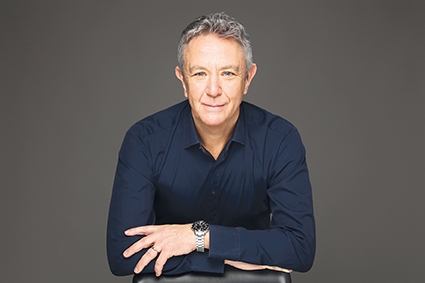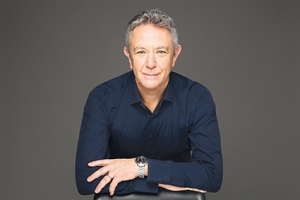John Licence on What Makes the Marriott Brands
Exclusive Interview
Mr. John Licence, Vice President Premium and Select Brands at Marriott International in Europe, trained as a chef in a London hotel. While cooking was his passion, he then decided to take a hotel management degree. 25 years ago he was a General Manager in London and was asked to move to a regional role. He agreed to it, and has been traveling around the world working for Marriott ever since. He’s been with the company 34 years and on his visit to Tbilisi last week, GEORGIA TODAY grabbed the opportunity to find out about the upcoming renovations on the Tbilisi Marriott Hotel and the new Tbilisi Moxy.
The Marriott
First, a little history. The hotel was designed by Aleksandr Ozerov in 1911 and later remodeled by Gabriel Ter-Mikelov. Construction was completed in 1915 and it was named Hotel Majestic. Before it could serve the public, war and the Soviet takeover of Georgia forced owners to put it to use as a military hospital and trade center. In 1939, the refurbished building was restored to its original function as Hotel Tbilisi run by the state-owned travel agency Intourist. Heavily damaged by fire during the December 1991–January 1992 coup d'etat, a prelude to the Georgian Civil War, it was reconstructed under the guidance of architects G. Metreveli and V. Kurtishvili from 1995 to 2002. On 26 September 2002, the Tbilisi Marriott Hotel was opened by GMT Group in the building.
“We’ll be renovating the rooms, restaurant and public areas of the Marriott hotel,” Licence informs us. “The renovations will reflect the history of the building but will bring it a contemporary feel. Each of the Marriott brands has certain guidelines to be followed. The ‘Great Room,’ like this space we have here, will feature high and low tables, cozy areas, and a central open bar area. We want to make sure it gets engaged into the local community again, with a beverage selection for both guests and passersby in order to attract locals and businessmen alike. The design will be a little less traditional, more flexible. You’ll come in and see someone at a high table working on a laptop, another on a sofa having a tea. It’s about creating a dynamic multifunctional space. The colors and other small details are being finalized now.”
We asked Licence how they go about a re-design and how much the locals are involved.
“We create model rooms, which in the Tbilisi case is close to completion, and we get an interior designer in, we brief them and get the hotel owner involved. The model room is reviewed and fine-tuned by a number of people. Once that room is agreed on, we go ahead and purchase what we need. We try to purchase locally and support the local community as far as possible, but we might order select pieces of furniture, for example, from other parts of the World. Everywhere we operate, we try to engage with the local community as much as possible in terms of what we do- that’s where success comes.”
Marriott is a global brand, so of course there are things people come to expect of a stay in one of its hotels, but local tastes and features are important so as to reflect the location in which guests are staying and to make each hotel stand out.
“International travelers need familiarity, but we also give them the opportunity to get a taste of the local flavor as well.”
The décor also aims to integrate local flavor, License tells us, and they never aim to cookie-cut their hotels.
“For each brand, we have interior design agencies that understand the brand requirements, based all over the world, etc. The hotel owner then chooses a designer, who comes to get a feel for the building and history. Here, the interior design will reflect the Georgian character.”
The Tbilisi Marriott renovation will go ahead in three stages in a well-practiced manner carefully controlled by a professional and experienced team whose aim is to disturb guests as little as possible. “It’s a bit like a military operation,” Licence says. Rooms are to be remodeled floor by floor at times of lower occupancy, starting in January and ending in April. After the rooms, the Great Hall will be done up, then the restaurant.
“The whole job is expected to take no more than a year and will result in a wonderful new product to relaunch on the market. I’m looking forward to it,” our interviewee says.
Moxy
Moxy was developed six years ago and launched three years ago. At the time, Marriott in Europe did not have a select or economy brand and the competitors that did offered, as Licence puts it “much of a muchness.”
“We wanted something to shake up the market; something that would appeal to the Millennial traveler”, Licence says. “What was missing was a hotel that had a great design and atmosphere where people could hang out in a social setting. Moxy being in the select segment means the rooms are a little bit smaller- of course, they have great beds, showers; everything you need in your room, but we looked to designing our public areas for the Millennial Traveler who likes to be in a social environment. We call our guests “fun-hunters” and we incorporated different zones- chill back, a play zone, an eating zone- guests come down from their rooms with a laptop, eat, drink and enjoy what’s going on around them.”
There will be 26 Moxys by year-end in Europe, and with more than 50 signed hotels in Moxy’s pipeline expected to open between now and year-end 2020, it is Marriott’s fastest growing brand in Europe, not just in capital cities but also in secondary cities and airport locations.
“There are 9 Moxys in Germany, four in the UK, two in Italy… we wanted to move to Eastern Europe. Having this hotel here and getting the exposure we are with potential owners coming in from Eastern Europe and elsewhere for the official opening this week is part of our strategy for expanding the brand in this region.”
We asked Licence how the Tbilisi Moxy had come about.
“GMT Group, our partner in Tbilisi, was looking to develop another hotel with us. They’d seen the Moxy brand in Europe and wanted it for Georgia. What they’ve delivered is excellent- the Tbilisi Moxy has a great location by the river and there’s a lot going on around it. The design follows the Moxy principle with a touch of Georgia, particularly in the coloring, the red. In the room there’s a very dramatic picture of a Georgian dancer and that generated a lot of discussion at first, but when you see it, you see it works- it looks…cool. The finish on the hotel, the lovely red Tbilisi bricks, the attention to detail in that location stands out. I love the metal entrance. There are always hotels that we tell future owners ‘if you want to see a good example of an active Moxy…’ now the Tbilisi Moxy is on that list.”
The Marriott Team
“At Moxy, we don’t call the managers ‘General Managers’ they are Captains and the staff are crews. Crew members need to be flexible. We hire for personality, for character. You can train skills but not character. Especially in a Moxy, you need that energy and ‘can do’ attitude. You should be able to check someone in, then serve them a cocktail!”
He emphasizes the fact that you can be successful in the hotel business by being flexible.
“If you’re prepared to be flexible and to travel, the world is your oyster,” he says, and he should know- having lived in both the US and Germany and traveled worldwide when dealing with the various brands. “I’ve been with Marriot 34 years, and never had to change company because there is always a new opportunity [internally]. Bill Marriott [founder] is still the Chairman, even though he’s in his mid-80s, he’s still in the office every day. He says: ‘Take care of the associates and they’ll take care of the customers,’ which is so true- there’s a great culture in Marriott which I don’t see in other companies.”
He goes on to tell us of the various hotels he has visited in Georgia, and elsewhere, whose staff started out at Marriott. “They still have a passion for Marriott,” he says. “Our culture and training opportunities set us aside. In Tbilisi, more hotels means more options for people to move around [in their hospitality careers]. We offer reams of training through online programs and direct face-to-face tutorials: core leadership training, presentation skills, discipline training. All managers have to do a training every year. And we make sure to sit down and talk to people. The company is very positive about asking people what they want to do and helping them do it, but they themselves need to have the drive and initiative to grab those opportunities.”
The Future
Technology is moving on, and the Marriott team is working on ways to ease guest movement. They already employ key-on-iPhone tech and online check in and out, meaning there’s no queueing.
“We need to drive business through the Marriott online system- last year we generated $14 billion in revenue through Marriott.com, and over 50% of our revenue comes through direct channels, the lowest cost channel for our owners and hotels. We saw the biggest growth in digital: iPhone keys, online check in-out and communicating with the hotel staff through a chat box,” Licence says. We have a department in our head office in the US that is focusing on future technology and regularly analyses the model rooms, looking for ways to improve them for added guest comfort. Automatic rooms that respond to individual guest requirements is one future direction.”
We ask him if he can envisage a future Marriott brand that is fully-automated.
“Robots? Never say never!” [he laughs] “Human interaction is an important part of the hospitality industry and provides memorable experiences. New technology should enhance an experience and remove barriers- like the no queuing aspect, which can now be done automatically. We’re trying to develop technology so our associates can spend more time giving guests a memorable experience. We might develop such a brand, but we’ll have 30 brands doing other things. What we do in Moxy is very different to what we do with other brands, say the Ritz Carlton or St. Regis, where people have a personal butler for their every need. There are always going to be changes in the industry, but we need to make sure that each brand has an individual character and element of service that differentiates them and fits customer needs. Some guests want the high-end touch, others want to come and sit on their laptop and be left alone. Our loyalty program has 110 million people. They know us and want us to know them well; to know how they travel what they need to make their stay with us personal.”
And the future in Georgia? we ask him.
“We have a strategy for Georgia and the region. We see huge opportunities for bringing other brands into the market,” he says. “So, watch this space.”
By Katie Ruth Davies












